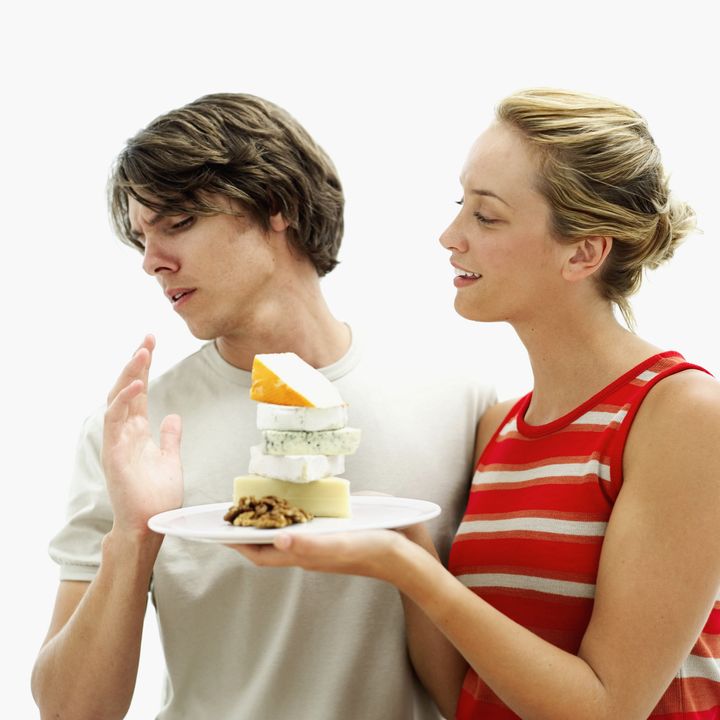
Last week, I read six articles with variations on the good-versus-bad-food theme. Good food? Bad food? It's funny how we attribute moral properties to what is, essentially, a glob of chemicals in a tasty package. Eating is supposed to provide nourishment and pleasure. But in our diet-obsessed culture, we have attributed to food a sometimes-sinister quality.
Here's one example: "Annie" was so tormented by her fear of food that she avoided parties and dinner invitations, because she didn't want to be tempted by the tasty treats. When she ate, she spent the entire meal adding and re-adding the number of calories she was consuming, and continued to do so well after she had finished the meal. She read labels obsessively, and could tell you the calorie count of almost any food--and usually the number of carbohydrates, fat and protein as well. At best, she regarded food with suspicion; at worst, it terrified her ...
Dieters are most susceptible to this mindset, but they're not the only ones. Other fear-inducing foods and ingredients include saturated fat, sugar, high-fructose corn syrup, trans fats, GMOs, gluten, dairy, soy, pesticides, refined carbs, wheat, diet sodas and anything that's even remotely related to increased risk of obesity, diabetes, inflammation, heart disease or cancer.
It's important to be wary of some of these. I'm a huge proponent of eating clean foods, and make my living writing about them. Will eating trans fats kill you? Perhaps. If you're sensitive to gluten, should you avoid bread? Absolutely. But prudence and mindful choices can sometimes go the way of fear.
Think of how children eat. When you offer a child a cookie, he doesn't think, "Dear god, that cookie was made with high-fructose corn syrup and trans fats! And it probably has 500 calories!" They think "Mmmm. Cookie. Sweet! Crunchy!" They eat the cookie, and have an experience of pure pleasure. Somewhere between the happily ignorant bliss of a child, and the ever-vigilant eye of a nutrition-savvy adult, there lies a middle path, one that doesn't include worry, stress and fear.
If you find yourself from time to time (or frequently) seized by a fear of food, here are some ways to loosen the grip:
1. Confront your fears. It's not the food you fear, it's the potential effect of that food. Write down what really scares you, and carry it to the worst possible outcome. It may look like this: "I'm afraid if I indulge my sweet tooth, I won't be able to stop. I'll gain a lot of weight until I'm morbidly obese. I'll be so fat, I wont' be able to go on business trips any more, and my boss will fire me. Then I'll be out of work, and I'll lose my house, and be homeless." Or maybe it's as simple as "I won't look good for my high school reunion, and my old friends will judge me." Whatever your fear, when it's on paper, it's easier to then decide if it's reasonable, or out of hand.
2. Get to know your food. When you're eating, just eat. Don't watch TV, work on your computer, read a book, drive, whatever. Look at the food on your plate, chew it slowly, really taste it. Be fully present, enjoy what you're eating, and then move on to the next thing. You'll soon find that even "off-limits" foods aren't really that scary. And notice what that food feels like in your body. Do you feel lousy after eating it? Maybe it won't be your first choice next time.'
3. Choose foods for the benefit. Rather than saying "no" to what you don't want, try saying "yes" to what you do want. Instead of saying "I can't drink coffee because it makes me jittery and makes my skin look bad," try saying "I choose to drink green tea because it's calming and makes my skin look healthier." Same end result--but instead of rejecting what you don't want, you're choosing instead what you do want.
4. Eat for quality. There's a lot of nasty food out there, and it's reasonable to be careful. But if you choose foods for quality, you'll eliminate many of the justifiable concerns, like agricultural chemicals, trans fats, sugar and so forth. If you enjoy cheese, choose organic varieties, and pay attention to how much you're eating. If you like sweets, go for raw, unfiltered honey, instead of high-fructose corn syrup. And if you shop for foods without labels--whole fruits and vegetables, nuts, seeds, dried beans--it's hard to go wrong.
5. Banish forbidden food. The concept, that is, not the food. Unless you have an overriding health concern--you're diabetic, or allergic to nuts, for example--it's really not necessary to outlaw any one food. When you make a food off-limits, you only increase the cravings. So if you love potato chips, but you avoid them because they're fried and high in sodium, have a few potato chips when you crave them.
6. Trust yourself. Speaking of potato chips, are you afraid you'll eat the whole bag? It's a common fear. When we fear food, it's not really the food we're afraid of. It's our uncontrolled reaction to it. A spoonful of ice cream turns into a quart, a few cookies turns into a whole bag. That may happen at first. But in my experience, when people allow themselves to remove the labels and indulge in a "forbidden" food, it soon loses its appeal. Once you see it as just another food, you're on your way to being free.